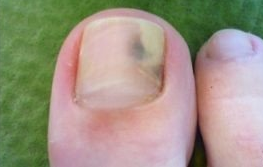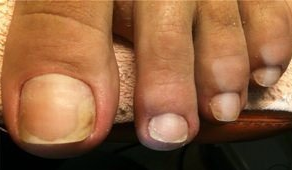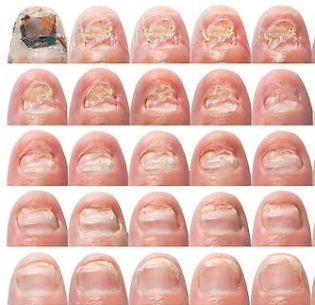Almost every third person has a nail fungus on my feet. The disease is called onychomycosis and causes delamination and crumbling of the nail plate. The onychomycosis can occur at any age require timely and proper treatment under expert guidance.

What is onychomycosis?
Onychomycosis - fungal infection of the nail plate. The disease can be caused by fungi dermatophytes or microspores. Fungi adversely affect the building Foundation of the nail keratin and gradually eating it, cause of the deformation changes.
The following types of onychomycosis:
- Normal scars. Change the color of the nail, streaks and stains.
- Hypertrophic. There is not only change color, but also easy to deformation. Most often, the nail becomes deformed with the edges.
- Onicholocheskiy. The nail is destroyed, atrophy and rejected.
Fungal infection may cause deformity of the nail at the free edge, the sides and rear of the cushion. As the disease process affects the entire nail plate.
Reasons
Fungus on toe nails appears not only because of low immunity. About 70% of people infected by a sick person, and this is frequently a relative. Tiny flakes of skin from feet fall on household items, and in contact with the healthy tissue of the nail or skin, to infect a healthy person.
Infection occurs most often through:
- Washcloths.
- Sponge.
- Towels.
- Mats.
- Shoes.
- Manicure accessories.

When you visit the beach, saunas and baths without Slippers there is a high risk of infection with a fungus of the feet. High humidity and temperatures, infection occurs much more often.
Especially attentive it is necessary to be in public places where people walk barefoot. Fungi as resistant to low and high temperatures and sand on the beach they retain their viability for several months.
The slightest wound and a scratch on the leg through contact with infected objects can cause onychomycosis. It is not necessary to continue wearing the shoes for other people, even when the external manifestations of fungus they detected. They can be carriers of pathogenic microflora, and with good immunity, the disease does not manifest itself.
Signs
The initial stage of fungus on the feet is manifested by dryness and peeling. At this time people may not notice visual changes nail plates, but he suffers from itching and burning in the fingers. Gradually increased sweating, in rare cases, there are blisters and corns. With the introduction of the fungus in the nail is beginning to change their color, they become brittle and cracked.
Nail under the microscope contains a mixture of and the void. Feet become smelly, but General symptoms increasing.
In severe cases, body temperature rises and there is severe painthat does not move normally. Looks like fungus of the toenails, and what changes are characteristic, in a lot depends on the type and strength of the human immune system.
The fungi dermatophytes appear yellow longitudinal stripes, yeast - cause flaking of the nail plate yellowing. Mold – the cause of superficial lesions of the nail plate, which can be yellow, brown, blue or green.
The description of the disease in different types of fungi is different but has common symptoms.
These include:
- The color change of the nail plates.
- Itching and burning of the skin of the toes.
- Stripes and spots under the nails.
- The crumbling and destruction of the nail at the sides.
- Redness of the skin around the nails.
- Hyperkeratosis (thickening of the nail).
The disease starts with lesions of the nail of the little finger or big toe, after which there is infection of all the plates. There is a cornification of the nail, it thickens and crumbles. Athlete's foot usually affects people of elderly and senile age, in children, they occur very rarely.

Treatment is engaged in dermatologist or mycologist. For accurate diagnosis is not enough visual inspections, and required laboratory studies. For this small part of the nail sent for microscopic examination. Upon detection of the fungus establish his view by seeding in nutrient broth.
Despite the fact that most diseases of the nail plates in adults, it is fungus, there are many pathologies with similar symptoms. The incidence of nail fungus can cause similar symptoms but requires different treatment. It is the felon, or an acute purulent inflammation of finger, which requires surgical treatment.
How to treat nail fungus?
Do not expect that the fungus will pass on their own. The longer a person suffers from this disease, the more difficult it will be to further treatment.
The duration of treatment and selection of drugs depends on:
- Stage of the disease.
- The degree of damage to the nail.
- Clinical forms of the disease.
The initial stage of nail fungus and foot require the use of local drugs, which can be in the form:
- Solutions.
- Ointments fungus.
- Creams.
- Varnishes.
To apply preparations for external use preferably after keratolytic treatment of the nail plate.
Before each treatment, the application of medicine is necessary:
- To make soap-soda bath. In a small bath add a tablespoon of baking soda and salt and 50 g of soap. Keep your feet in the solution for about 15 minutes.
- To treat the damaged nail. With a special nail file the top layer of the nail off so the medication is better absorbed.
- Apply the medication. The drug is applied to clean, dry toenails and the skin around them.
When you use solutions, ointments and creams, the drug is applied 2-3 times a day, lucky – 2 times a week. The course of treatment determines the physician depending on existing damage.
If the nail plate is completely shocked and the local drugs do not have a positive impact, recommended to combine them with system antimykotika.
Systemic medications have a long list of contraindications and should be appointed by the attending physician. Most of them are prohibited to take during pregnancy and lactation, in childhood and in chronic diseases of the liver and kidneys.

In severe cases, under-nail fungus can require removal of the nail plate. Procedure can be done as surgically, and with the help of keratolytic which contain salicylic acid and urea.
The removal of the affected nail keratolytic patches differs by its convenience. After steaming foot patch gently applied to the affected nail plate and sealed with adhesive plaster. In a few days the plaster is removed, cut the affected areas of the plate, causing one of the antifungal drugs. The procedure can be performed several times.
During treatment it is important to exclude the risk of repeated self-infection. This entire Shoe is treated with a special disinfectant solution. From socks that were worn before treatment, it is better to get rid of. In the future each month, a second treatment of footwear and clothing. If you refuse this procedure, after a short time the fungus may reappear.
The symptoms and fungus treatment is quite individual, and at the first sign of the disease should consult a doctor. Only he will be able to make an accurate diagnosis and choose an effective drug. Otherwise, the fungus will spread to other nails and completely destroy them.





























